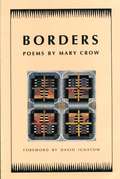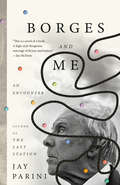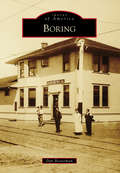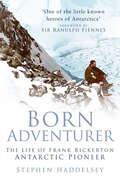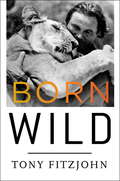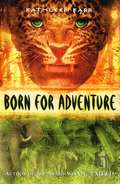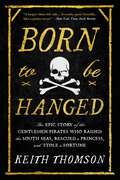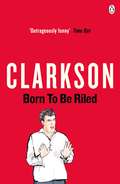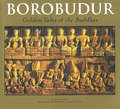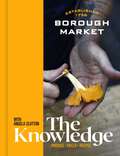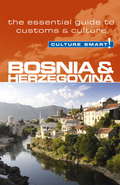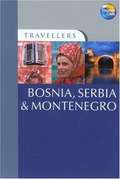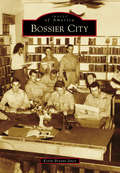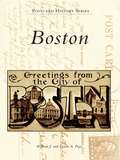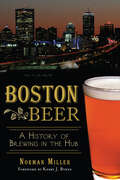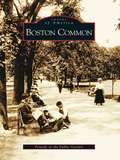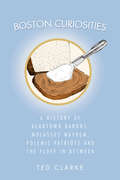- Table View
- List View
Bored? Games!: 101 games to make every day more playful, from the author of THE FLOOR IS LAVA
by Ivan BrettThe author of the smash hit, The Floor is Lava, is back with 101 fun-filled, boredom-busting games to occupy the whole family during the summer holidays. Starting to get fed up of endless games of Would You Rather? Or is screen-time taking over your life? Well, this is the book to bring everyone together, with an endless selection of creative games you can come back to time and time again.You'll quickly find the right game to match ANY occasion with games for one, for pairs or for groups. Most are quick to set up and require minimal equipment - ideal for anyone looking for straight up fun. Bored? Games! is the ultimate book of games to keep everyone entertained.There's games for any occasion: * Rainy days* Around the table games* Single-player games* Games for groups* Travel games* Summer holiday ideasNO BATTERIES REQUIRED.
Bored? Games!: 101 games to make every day more playful, from the author of THE FLOOR IS LAVA
by Ivan BrettThe author of the smash hit, The Floor is Lava, is back with 101 fun-filled, boredom-busting games to occupy the whole family during the summer holidays.Starting to get fed up of endless games of Would You Rather? Or is screen-time taking over your life? Well, this is the book to bring everyone together, with an endless selection of creative games you can come back to time and time again.You'll quickly find the right game to match ANY occasion with games for one, for pairs or for groups. Most are quick to set up and require minimal equipment - ideal for anyone looking for straight up fun. Bored? Games! is the ultimate book of games to keep everyone entertained.There's games for any occasion: * Rainy days* Around the table games* Single-player games* Games for groups* Travel games* Summer holiday ideasNO BATTERIES REQUIRED.
Borges and Me: An Encounter
by Jay PariniAn apprentice writer has an entirely unexpected encounter with literary genius Jorge Luis Borges that will profoundly alter his life and work. A poignant and comic literary coming-of-age memoir. "This is a jewel of a book." --Ian McEwanIn 1971 Jay Parini was an aspiring poet and graduate student of literature at University of St Andrews in Scotland; he was also in flight from being drafted into service in the Vietnam War. One day his friend and mentor, Alastair Reid, asked Jay if he could play host for a "visiting Latin American writer" while he attended to business in London. He agreed--and that "writer" turned out to be the blind and aged and eccentric master of literary compression and metaphysics, Jorge Luis Borges. About whom Jay Parini knew precisely nothing. What ensued was a seriocomic romp across the Scottish landscape that Borges insisted he must "see," all the while declaiming and reciting from the literary encyclopedia that was his head, and Jay Parini's eventual reckoning with his vocation and personal fate.
Boring
by Dan BossermanBob Boring, great-grandson of the Civil War veteran who lent his name to the community, says, "Boring is a name, not a condition." The recent pairing of Dull, Scotland, and Boring, Oregon, has created worldwide multimedia reports, including articles in Time magazine and the Wall Street Journal that published the same week. Never incorporated as an official entity, Boring has been a thriving farm, logging, and sawmill community since Joseph and Sarah Boring traveled the Oregon Trail in an ox-drawn covered wagon and settled here in 1853. The "downtown" area of Boring is only four blocks long, but the farming area serviced by the Boring Post Office is 13 miles long and contains a population of 8,000.
Born Adventurer: The Life of Frank Bickerton Antarctic Pioneer
by Ranulph Fiennes Stephen HaddelseySoldiers and sailors, geographers and geologists, submariners and balloonists all flocked to Antarctica during the ‘Heroic Age’ of Polar exploration. No one better represented this eclectic band than Frank Bickerton, engineer on Douglas Mawson’s Australasian Antarctic Expedition (AAE) of 1911–14. A true pioneer of Antarctic exploration, he piloted the expedition’s ‘air-tractor’, established the first crucial wireless link between Antarctica and the rest of the world, and discovered one of the first meteorites ever to be found on the continent.Treasure-hunter, explorer, fighter pilot, entrepreneur, big-game hunter and movie-maker, Bickerton not only made a major contribution to the success of the AAE, but was also recruited by Ernest Shackleton for his ill-fated Endurance Expedition, dug for pirate gold on Robert Louis Stevenson’s Treasure Island, survived bloody dogfights over the Western Front during the First World War, and flirted with the glittering world of 1920s Hollywood.In Born Adventurer, historian Stephen Haddelsey draws on unique access to family papers, journals and letters to provide a thrilling account of Bickerton’s rich and colourful life.
Born Wild: The Extraordinary Story of One Man's Passion for Africa
by Tony FitzjohnTony Fitzjohn, part missionary, part madman, has been called "one of the world's most endangered creatures." An internationally renowned field expert on African wildlife, he is best known for the eighteen years he spent helping Born Free's George Adamson return more than forty leopards and lions--including the celebrated Christian--to the wild in central Kenya. Born Wild is the memoir of Fitzjohn's extraordinary life. It shows how a man driven by an impossibly restless spirit can do almost anything, from being a bouncer in a brothel, to surviving a vicious lion attack, to fighting with the Tanzanian government, to being appointed an Officer of the Order of the British Empire by the Queen. A notorious hell-raiser given to scrapes with bandits, evil policemen, and wicked politicians, who has been shot at by poachers and chewed up by lions, Fitzjohn is also a wonderful raconteur. Shenanigans aside, he belongs to that rare species of humans who have sought refuge and meaning in a life truly dedicated to the restoration of the animal kingdom. Many times Tony Fitzjohn has put his life on the line for the cause in which he believes. Born Wild is the story of that passion.
Born for Adventure
by Kathleen KarrWhen young Tom Ormsby cons his way onto the great explorer Henry Morton Stanley's "Relief of Emin Pasha Expedition" in 1887, he's looking for adventure. But he has no idea what lies ahead of him. From the exotic bazaars of Zanzibar to the mouth of the Congo River and beyond, Tom soon learns he's signed on for more than the rescue of the mysterious Pasha. He's on a journey through the ravishing beauty and brutality of a jungle world peopled by slavers, warring tribes, cannibals, and colonial masters - all jockeying for survival in 19th-century Africa. As Karr follows Tom's remarkable three-year trek, she raised some provocative questions about slavery, the right of one country to impose its cultural imperatives on another, and the arrogance that can prevent a man from achieving his ultimate goal. Startling, scary, and surprising, this true story takes the reader deep into the heart of the African past.
Born in the Year of Courage
by Emily CroffordIt is the mid-1800s and Manjiro, a young fisherman, is shipwrecked far off the coast of his native Japan. <p><p> At this time in history, Japan is an isolated country that allows its citizens no contact with the rest of the world. Foreigners are called "barbarians"—and none are more despised than Americans. But when Manjiro and his fishing companions are rescued by an American ship, Manjiro makes some startling discoveries about the world of the barbarians—and about his own country. <p><p> His dramatic rescue leads to a series of amazing escapades, and in the end Manjiro travels farther than he ever dreamed he would. Born in the Year of Courage is based on the true story of Manjiro's remarkable life. It is both an exciting adventure tale and a fascinating look at a bygone world.
Born to Be Hanged: The Epic Story of the Gentlemen Pirates Who Raided the South Seas, Rescued a Princess, and Stole a Fortune
by Keith ThomsonDiscover the &“fascinating and outrageously readable&” account of the roguish acts of the first pirates to raid the Pacific in a crusade that ended in a sensational trial back in England—perfect for readers of Nathaniel Philbrick and David McCullough (Douglas Preston, #1 New York Times bestselling author of The Lost City of the Monkey God) The year is 1680, in the heart of the Golden Age of Piracy, and more than three hundred daring, hardened pirates—a potent mix of low-life scallywags and a rare breed of gentlemen buccaneers—gather on a remote Caribbean island. The plan: to wreak havoc on the Pacific coastline, raiding cities, mines, and merchant ships. The booty: the bright gleam of Spanish gold and the chance to become legends. So begins one of the greatest piratical adventures of the era—a story not given its full due until now.Inspired by the intrepid forays of pirate turned Jamaican governor Captain Henry Morgan—yes, that Captain Morgan—the company crosses Panama on foot, slashing its way through the Darien Isthmus, one of the thickest jungles on the planet, and liberating a native princess along the way. After reaching the South Sea, the buccaneers, primarily Englishmen, plunder the Spanish Main in a series of historic assaults, often prevailing against staggering odds and superior firepower. A collective shudder racks the western coastline of South America as the English pirates, waging a kind of proxy war against the Spaniards, gleefully undertake a brief reign over Pacific waters, marauding up and down the continent.With novelistic prose and a rip-roaring sense of adventure, Keith Thomson guides us through the pirates&’ legendary two-year odyssey. We witness the buccaneers evading Indigenous tribes, Spanish conquistadors, and sometimes even their own English countrymen, all with the ever-present threat of the gallows for anyone captured. By fusing contemporaneous accounts with intensive research and previously unknown primary sources, Born to Be Hanged offers a rollicking account of one of the most astonishing pirate expeditions of all time.
Born to Shop London: The Ultimate Guide for People Who Love to Shop
by Suzy GershmanFor over twenty years, Suzy Gershman has been leading savvy shoppers to the world's best finds. Now Born to Shop London is easier to use and packed with more up-to-date listings than ever before.
Born to be Riled
by Jeremy ClarksonBorn to be Riled is a collection of hilarious vintage journalism from Jeremy Clarkson. Jeremy Clarkson, it has to said, sometimes finds the world a maddening place. And nowhere more so than from behind the wheel of a car, where you can see any number of people acting like lunatics while in control (or not) of a ton of metal.In this collection of classic columns, first published in 1999, Jeremy takes a look at the world through his windscreen, shakes his head at what he sees - and then puts the boot in. Among other things, he explains:• Why Surrey is worse than Wales• How crossing your legs in America can lead to arrest• The reason cable TV salesmen must be punched • That divorce can be blamed on the birth of JesusRaving politicians, pointless celebrities, ridiculous 'personalities' and the Germans all get it in the neck, together with the stupid, the daft and the ludicrous, in a tour de force of comic writing guaranteed to have Jeremy's postman wheezing under sackfuls of letters from the easily offended. Praise for Jeremy Clarkson:'Brilliant . . . laugh-out-loud' Daily Telegraph'Outrageously funny . . . will have you in stitches' Time OutNumber-one bestseller Jeremy Clarkson writes on cars, current affairs and anything else that annoys him in his sharp and funny collections. Clarkson On Cars, Don't Stop Me Now, Driven To Distraction, Round the Bend, Motorworld and I Know You Got Soul are also available as Penguin paperbacks; the Penguin App iClarkson: The Book of Cars can be downloaded on the App Store.Jeremy Clarkson because his writing career on the Rotherham Advertiser. Since then he has written for the Sun and the Sunday Times. Today he is the tallest person working in British television, and is the presenter of the hugely popular Top Gear.
Borneo, Celebes, Aru
by Alfred Russel WallaceRacked with fever, virtually broke and earning a precarious living through sending back to London the plumes of beautiful birds, Wallace (1823-1913) ultimately became one of the most heroic and admirable of all scientist-explorers. Whether living with Hill Dyaks or hunting Orang-Utans or sailing on a junk to the unbelievably remote Aru islands, Wallace opens our eyes to a now long vanished world.Great Journeys allows readers to travel both around the planet and back through the centuries – but also back into ideas and worlds frightening, ruthless and cruel in different ways from our own. Few reading experiences can begin to match that of engaging with writers who saw astounding things: Great civilisations, walls of ice, violent and implacable jungles, deserts and mountains, multitudes of birds and flowers new to science. Reading these books is to see the world afresh, to rediscover a time when many cultures were quite strange to each other, where legends and stories were treated as facts and in which so much was still to be discovered.
Borobudur
by John Miksic Anita Tranchini Marcello TranchiniThis book is intended to enhance the enjoyment which one obtains from Borobudur and its reliefs, by describing what is known of the ancient Javanese who built it and of the symbols which they employed to express their conception of man's place in the universe.
Borobudur
by John Miksic Anita Tranchini Marcello TranchiniThis book is intended to enhance the enjoyment which one obtains from Borobudur and its reliefs, by describing what is known of the ancient Javanese who built it and of the symbols which they employed to express their conception of man's place in the universe.
Borough Market: Produce – Skills – Recipes
by Angela CluttonBorough Market: The Knowledge provides stories, skills and expert advice from the market's traders, plus over 80 exciting recipes from award-winning food writer Angela Clutton that will help you make the most of their exceptional produce. With stunning atmospheric photography, this is the definitive guide to shopping and cooking for every kitchen.Find intriguing in-depth features and unmissable Q&As with traders, along with visual step-by-step guides to preparing ingredients and lists of interesting seasonal produce. Moving through meat, fish, vegetables, fruit, dairy, bakery and store-cupboard ingredients, each chapter shares a collection of tantalising recipes that will teach you how to make the most of your produce, inspired by the incredible seasonal offerings from Borough Market traders.Recipes include Fishmonger's pie with fish crackling; Baked gammon with Market preserve glaze; Parsnip gnocchi and smoked garlic butter; Walnut and pomegranate baby aubergines with saffron quinoa; Brown bread Victoria sponge with orange and saffron curd; Chocolate olive oil cake with figs and hazelnuts.Come away feeling confident and excited to use your newfound understanding of ingredients, armed with the market traders' unrivalled expertise and delightful seasonal recipes.'Borough Market: The Knowledge is a treasure trove of culinary wisdom and inspiration that captures on paper the magic and the bustle of Borough Market. Its pages are brimming with exquisite produce, recipes, stories and practical tips that will transform the way you shop and cook for the better. This is a book that makes me long to cook (and to eat!).' - Skye McAlpine, author and creator of the blog From My Dining Table
Borough Market: Produce – Skills – Recipes
by Angela CluttonBorough Market: The Knowledge provides stories, skills and expert advice from the market's traders, plus over 80 exciting recipes from award-winning food writer Angela Clutton that will help you make the most of their exceptional produce. With stunning atmospheric photography, this is the definitive guide to shopping and cooking for every kitchen.Find intriguing in-depth features and unmissable Q&As with traders, along with visual step-by-step guides to preparing ingredients and lists of interesting seasonal produce. Moving through meat, fish, vegetables, fruit, dairy, bakery and store-cupboard ingredients, each chapter shares a collection of tantalising recipes that will teach you how to make the most of your produce, inspired by the incredible seasonal offerings from Borough Market traders.Recipes include Fishmonger's pie with fish crackling; Baked gammon with Market preserve glaze; Parsnip gnocchi and smoked garlic butter; Walnut and pomegranate baby aubergines with saffron quinoa; Brown bread Victoria sponge with orange and saffron curd; Chocolate olive oil cake with figs and hazelnuts.Come away feeling confident and excited to use your newfound understanding of ingredients, armed with the market traders' unrivalled expertise and delightful seasonal recipes.'Borough Market: The Knowledge is a treasure trove of culinary wisdom and inspiration that captures on paper the magic and the bustle of Borough Market. Its pages are brimming with exquisite produce, recipes, stories and practical tips that will transform the way you shop and cook for the better. This is a book that makes me long to cook (and to eat!).' - Skye McAlpine, author and creator of the blog From My Dining Table
Bosnia & Herzegovina - Culture Smart!: The Essential Guide to Customs & Culture
by Elizabeth HammondAvoid being offended, or worse offending Bosnian locals, instead familiarise yourself with local customs and cultures by reading Culture Smart! Bosnia. This handy, pocket-sized book will help you to ease your way into a different culture and will assist you in making sure you don't develop incorrect stereotypes. Good preparation can go a long way in readying yourself for your journey. Whether you are setting off to Bosnia in order to travel, learn, work or relocate, Culture Smart! will provide you with a wealth of information on everything from climate, population, doing business, nightlife and so much more. Culture Smart! Bosnia offers an in-depth insight to the customs and cultures of Bosnia, an area where many other guidebooks only scratch the surface.
Bosnia, Serbia And Montenegro
by Tim ClancyBrand new for 2007, "Travellers Bosnia, Serbia & Montenegro" is perfectly designed for mainstream travellers who want to access the best of this beautiful and hotly tipped region. This book delivers: expert advice, tracking down the best sights and experiences; Suggested Itineraries and Highlights sections for inspired trip planning; detailed background on people, geography, culture and history; clear and accurate mapping for orientation at country, region and city levels; suggested walks and tours to somewhere a little different; impartial and dependable sleeping, eating and entertainment listings. It is full colour throughout, with over 140 photographs. There is comprehensive coverage of this area's finest, including Sarejevo, the Bay of Kotor, Belgrade, Mostar, Pristina and Podgorica. "Travellers" are popular, compact guides for mainstream travellers wanting to discover something a little different on their trip. Covering the very best of country, regional and city destinations, they offer the perfect balance of culture, history, practical information, mapping, photography and listings to appeal to a mass-market readership.
Bossier City
by Kevin Bryant JonesBossier City sprung up around cotton fields, railroads, steamboats, and factories as the little town across from Shreveport. Today, the city thrives as the fastest growing in Louisiana. The tight-knit community of citizens who have called Bossier City home for several generations has grown to include an influx of newer transplants and Air Force personnel. "Old Bossier" remains the heart of the city, and its established families and businesses are proud to retain the simple nature of the past. This book remembers days of community and closeness, capturing the era when people built their own houses out of materials they had, walked downtown to a diner or market, and saw the first bomber fly overhead. This collection captures 1920s architecture, hardworking residents, and downtown roots but also celebrates the emergent and progressive nature of Bossier City. Today, the arts are flourishing, the stores are busy, the Barksdale Air Force Base is the jewel of the city, and the strong community identity is continually evolving.
Boston
by Elaine A. Pepe William J. PepeFrom 1901 to 1960, the picture postcard recorded almost every aspect of life in the city of Boston. Through the vintage postcards in Boston, readers will tour the city's Emerald Necklace and green spaces, visit Boston's old waterfront, understand Boston's part in America's Revolutionary War, and see the diversity of the city's many museums, churches, libraries, colleges, and internationally famous hospitals. Postcard images depict the many events that have shaped the historic city of Boston.
Boston Beer: A History of Brewing in the Hub (American Palate Ser.)
by Norman Miller&“Recounts Boston&’s long and storied history with beer—including the story of how the Green Dragon Tavern became the birthplace of the Revolutionary War.&” —Pulse Since before Patriots like Paul Revere and Sam Adams fermented a revolution in smoky Beantown taverns, beer has been integral to the history of Boston. The city issued its first brewing license in 1630, and breweries like Haffenreffer Brewery and American Brewing Company quickly sprung up. This heady history took a turn for the worse when the American Temperance Movement championed prohibition, nearly wiping out all of the local breweries. In 1984, the amber liquid was revitalized as Jim Koch introduced Samuel Adams craft brews to the Hub and the nation. Shortly after, Harpoon Brewery emerged and became the largest brewery to make all its beers in New England. From the planning of the Boston Tea Party over a pint at Green Dragon Tavern to the renaissance of the burgeoning craft brewing scene, join author and &“Beer Nut&” Norman Miller as he savors the sudsy history of brewing in the Hub. &“Boston Beer&’s strengths lie in the interviews and attention to detail about the last few decades of Boston brewing, and those interested in the behind the scene stories of Boston&’s craft beer innovators will enjoy this read.&” —Malcolm Purinton, Yankee Brew News &“A brief but interesting history of brewing in Boston from Colonial times through Trillium.&” —Two-Column Barley &“Miller&’s Boston Beer focuses on the city itself. His story begins with the role tavern life in general, and beer in particular, played in the unfolding drama of the American Revolution on the streets of Boston.&” —Boston Herald
Boston Chef's Table: Extraordinary Recipes from Beantown
by Clara SilversteinMore than 50 Recipes from the Longstanding Restaurants in Beantown The Boston Chef&’s Table brings recipes from the best chefs in the Boston area right to your kitche. Included are favorites from Lydia Shire, Joanne Chang, Jody Adams, and more. Far from being standard, contemporary recipes represent the very best Boston has to offer, from Roasted Pear and Goat Cheese Salad to Swordfish with Apple Caponata to the classic Hot New England Lobster Roll. Inside you&’ll find: 50+ recipes customized for home cooks from longstanding Boston institutions Savory color photos of recipes and the chefs who invented them Contact information and profiles on famous chefs and restaurants in Boston Sidebars spotlighting the city&’s culinary history and ethnic food enclaves
Boston Common (Images of America)
by Friends of the Public GardenThe nation's oldest and most venerated public park, Boston Common has belonged to the people of Boston since 1634. Throughout its history, it has been a centerpiece of civic life; the scene of executions, sermons, protests, and celebrations; and in each century, host to famous visitors from Generals Washington and Lafayette to Rev. Martin Luther King Jr. and Pope John Paul II. In Colonial times, it served as a meeting place, pasture, and military training field. Bostonians in the 19th century added treelined malls and paths and, following the Civil War, monuments and fountains. However, for all its adaptation to modern life, Boston Common remains a green retreat remindful of its storied past.
Boston Curiosities: A History of Beantown Barons, Molasses Mayhem, Polemic Patriots and the Fluff in Between
by Ted ClarkeA collection of odd and obscure moments in Boston history, starring colonists and criminals, baseball players and barmaids, and many more. Boston has been a favorite backdrop for novels, films, and television series, but some of the best stories about the city are true ones. Historian Ted Clarke explores these stories, both the familiar and the obscure, that have earned Boston such nicknames as &“the epicenter of American crime fiction,&” &“the cradle of liberty,&” and &“the ice cream capital of the world.&” The fifteen-foot tidal wave of molasses that roared down Commercial Street in 1919 is one of the more famous legends. Lesser known, but equally stunning, is the case of Albert Tirrell, who in 1845 murdered his mistress in a Boston boardinghouse but was released after presenting the first successful sleepwalking defense in the United States. From the mysterious story of John Jacob Loud, who patented the first ballpoint pen, to the dubious early enterprises of merchant prince turned philanthropist Thomas Perkins, Boston Curiosities offers up a medley of memorable events that give Beantown its celebrated flavor
